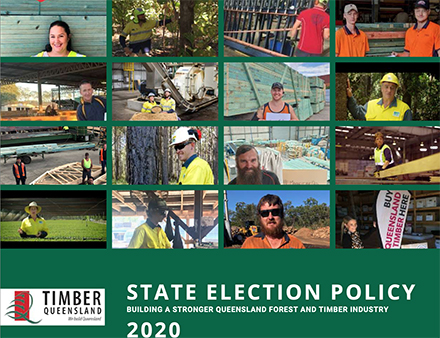Timber Queensland has certainly put in the work in the lead-up to Saturday’s Queensland election. And in doing so, they may have set something of a benchmark for other State timber organisations to follow, if they haven’t already. Source: Bruce Mitchell
By formulating a five-point plan for the two major parties to respond to Timber Queensland managed to set an agenda for the election, and the responses from the Government and the Opposition are well worth reading.
The LNP needs a net gain of nine seats to oust the Palaszczuk government without having to rely on deals with crossbenchers.
So far it seems the major timber-related seats in Queensland such as Labor’s Bruce Sanders in Maryborough and the LNP’s Tony Perrett in Gympie are pretty safe.
The Courier Mail has identified 13 seats it says will make the difference, and in none of them is the timber industry identified as a major issue.
According to The Australian, the fly in the ointment seems to be the LNP’s plan to put Labor last on how-to-vote cards statewide — effectively preferencing One Nation.
This has understandably upset multicultural community leaders who are concerned Pauline Hanson’s party’s hold on power might increase from its current single seat in Queensland.
A powerful coalition of multicultural leaders is blitzing Queensland’s foreign-language newspapers with advertisements warning voters against backing One Nation or any party preferencing the minor party — in a shot at the Liberal National Party.
But Annastacia Palaszczuk and the Labor Party remain clear favourites to return to government.
What is possibly worrying the timber industry could be Labor stalwart Grace Grace becoming a casualty to the Greens alongside Jackie Trad tomorrow meaning Ms Palaszczuk might have to do a deal to form government.
Meanwhile in New Zealand the newly re-elected PM Jacinda Ardern has had some tough decisions to ponder, the big one of which has been to embrace the Greens or leave them on the outer.
Whether the Greens join the Government this weekend is irrelevant; Ms Ardern had made it clear that this will be a Labour Government, governing from the centre.
Labour holds almost all the cards, with a four-seat majority after its landslide election victory. But the Dominion Post reports Ms Ardern has been talking up the talent in the Green Party suggesting she will want to give some of its MPs ministerial portfolios and would be able to blunt some criticism from her left by doing so.
Greens co-leader James Shaw, an old friend of Ms Ardern, seems a sure bet to keep his role as Climate Change Minister, but the Green Party’s members will want more than just some jobs.
If they do come to an agreement, Labour’s position of strength means it can be more selective about what it consults the smaller party about, according to Auckland University’s politics professor Jennifer Curtin.
General thinking is that Labour will be considering including the Greens in some form, maybe as associate members outside of cabinet.
As Ms Curtin pointed out, not being in the inner circle would deny the Green party information but would give the Greens the advantage of being free from the secrecy rules that come with being in cabinet.
It also might save it the harsh penalties that small governing parties face at subsequent elections, a price paid by New Zealand First which was voted out of parliament two weeks ago.
Both election results will, ultimately, be of great interest to the timber industry in both countries.






